The quest for traction is every founder’s obsession, especially in the early days. And like plenty of startup founders before him, Knoetic founder & CEO Joseph Quan was having a tough time finding product/market fit. His previous company, focused on HR & people analytics, had just gone through a full team rebuild, lost several key customers and now had just six months of runway left in the bank. Then, to top it all off, March 2020 hit. “All of a sudden, no one was interested in people analytics anymore. Prospects didn't care, customers didn't care — they were just scrambling to understand how to respond to the existential threat of COVID. Do they need to prepare for a layoff? Were we entering a multi-year recession?” says Quan.
With sales interest in the product plummeting and runway shrinking, Quan went all in and pivoted the entire company to what he now calls their moat — community. There are still plenty of misconceptions around community, especially in the earliest stages of company building. It’s a fuzzy concept with all sorts of different implementations, from running a series of events to starting a Slack group, to building a comments section into your site. And most founders consider community something to tack on as an afterthought, post-finding product/market fit.
Early on as a founder, Quan had many of those same misgivings. But with Knoetic running on fumes in March 2020, he decided to try a different approach and spun up a community aimed at helping Chief People Officers navigate the COVID crisis. It was a simple offering with a very small membership: just 25 HR leaders who convened to share the best resources on pandemic response, shifting to remote work, and all the other emerging challenges their companies would face in 2020.
“Before I built a community, I had a very narrow view as an entrepreneur. I’d thought about building an analytics tool that just gave you data and numbers. But that’s only half of the equation. A Chief People Officer needs to have more than data and metrics on their own company — they need to know what’s happening outside of their four walls. What are the top companies in our industry doing? What’s best practice? Who’s built the best playbook for this? Those are questions you can only answer by bringing experts together. That’s where community comes in,” he says.
Over the course of the next 12 months, that kernel of an idea evolved into the world’s largest network for hypergrowth Chief People Officers (now called CPOHQ), counting over 1,000 people executives from companies like Roblox, Glossier, and Figma as members. Quan attributes the magic of community to single-handedly helping Knoetic win, including raising its Series A in under 2 weeks, bringing over 100 Chief People Officers onto their cap table, unlocking a real-time pulse of what features his team should build, and growing their business over 400% over the course of 2021.
Community reframes your startup by starting with the people that you're bringing together — not the product prototype you're envisioning in your head.
In this exclusive interview, Quan makes the case that community must be driven by well-defined cultural principles, and why it’s worth investing in early to get closer to your customers, not something to try out once you’ve hit scale. He also connects the dots in between, “Hey, maybe we could try this community thing?” to running a hit community for C-suite startup leaders. Along the way, he outlines a step-by-step guide to get your first 1,000 community members, including validating the idea, developing a roadmap with your customers, and measuring success. He also points out a few potholes at each step that might throw you off course. Finally, he outlines his playbook for using community to supercharge your fundraising, sales and product initiatives. Let’s dive in.
STEP 1: RUN SOME CHEAP TESTS, DO YOUR “COMMUNITY DISCOVERY,” AND BUILD A WEDGE.
Substep 1A: Run the cheapest test of all: an email campaign.
With Quan’s best-laid plans for Knoetic upended in March 2020, he spun up a quick test to validate a few different ideas for the direction in which to pivot. “We queued up several outbound email campaigns targeting CHROs advertising different ideas we were considering building: A tool to help analyze the impact of layoffs, a remote work productivity suite, and an exclusive community for CPOs and CHROs. We hadn’t built any of those things yet, but we knew we could build any of them within a month,” says Quan. “The idea was just to validate the demand for a new direction we would go. As it turns out, the email campaign advertising our community idea got higher engagement than any email I’ve ever written in my life. Something like 40% of the C-Level executives we reached out to responded to the email. It was clear we had a winner.”
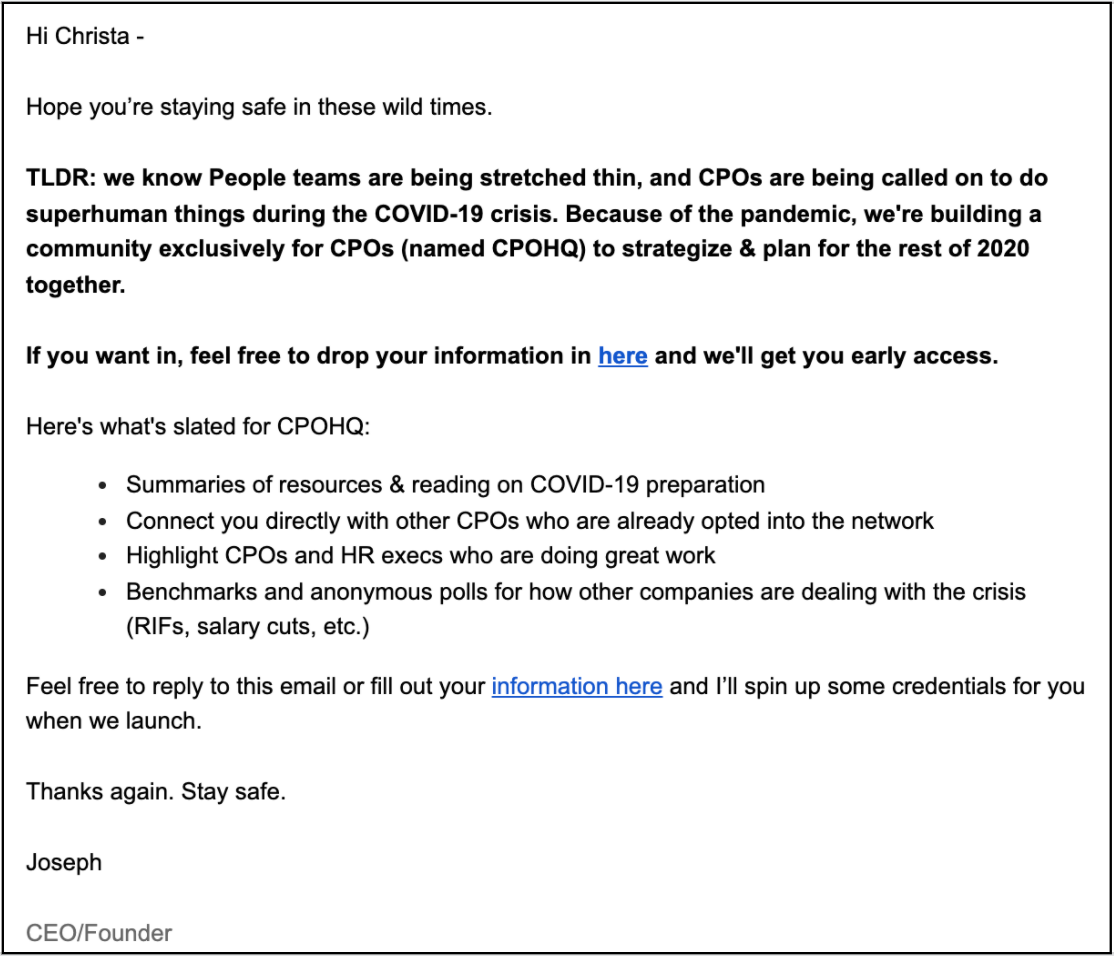
Substep 1B: Run “community discovery” just like customer discovery.
But to build a community with staying power, Quan needed to dig into what was missing in the market. Over a five-day sprint, he interviewed over a dozen Chief People Officers on what networks they were already in, what they liked about them, and how Knoetic could build a truly differentiated community. “I knew there were a bunch of HR communities already — why were they failing to serve this CPO audience? By doing community discovery, I was able to unearth some core differentiators for us,” he says. “As simple as it sounds, by adhering to these principles, we were able to distance ourselves from other existing networks for CHROs and CPOs.”
Too often when founders build a product or a community, they aren’t sure who will be attracted to the idea. That is a mistake — be very specific about who you’re building for.
Armed with insights from the discovery process, Quan’s guiding principles to differentiate the community became:
- Define who your community is for and, even more importantly, who it’s not for. “We said from Day 1, this is going to be for one single People/HR leader in each company, and we’d never change that. Unfortunately, many communities fail to adhere to this principle — you start with a community exclusively for C-level executives, and they’re pouring their hearts out, sharing their most personal challenges. Then a year later, it’s all line managers asking less strategic questions. Before long, you have a bunch of people who are new on the job, asking entry-level questions like, ‘How do I install a new HR system?’ or ‘How do I write a job requisition?’” says Quan. “Over time, you end up losing this burning hot ember of what makes your community special, because your original members no longer believe this is a place where they can have strategic, honest conversations with fellow execs. We were very disciplined about who would make it in, and who we kindly had to turn down. This rigorous focus on member standards might put an upper limit on your membership, but the tradeoff to get higher quality conversations is worth it.”
- Make it easy for members to find the insights they need. “I noticed in my community discovery that countless Chief People Officers mentioned how frustrated they were with the ‘knowledge management’ of their existing networks. They kept seeing the same questions being asked over and over again, which discouraged them from sharing their wisdom — they knew their answer would get lost again in a few days. That, in turn, pummeled engagement in existing CHRO communities. We knew from Day 1, Knoetic needed to overinvest in building the technical infrastructure to make search, content tagging and indexing incredibly easy. And we’d need to hire an editorial, community, and moderation team to almost act as a concierge to manually surface the best content to community members,” says Quan.
- Bet big on a standalone app, rather than a Slack or email group. “Our team was divided into two camps. Some folks wanted to start by creating a Slack or email group, citing how low friction they are to join. I reflected on my experience joining dozens of Slack groups — they are easy to join, but equally easy to forget. My gut said we wanted a stickier offering,” says Quan. “I also didn’t want a third-party app to kneecap our longer-term ambitions to build out custom features. We debated the pros and cons and decided to create a standalone experience, building an entire webapp for our community from the beginning. The burden of proof was a lot higher to get people into a net-new habit of going into an app. But as long as we nailed the value proposition, community members would justify the friction of joining a new app.”
The friction to joining a Slack community is low, but the friction to forgetting about a Slack community is also low. We wanted to build the muscle memory of logging into a new app, a distinct URL, and commit to creating a community that would justify this new habit.
- Mistake to avoid at this step: “You’ve got to have founder involvement in the early days of your community efforts. Trying to outsource the community from day one is a big mistake. You need that buy-in and passion from the founders to build something that stands the test of time,” says Quan.
STEP 2: SPIN UP A SCRAPPY MVP AND EARN THE RIGHT TO BUILD MORE.
With a large vote of confidence during the customer discovery phase and clear marching orders on how to differentiate from existing communities, the Knoetic team went into hyperdrive to build an MVP. “For everyone who responded to our initial advertising email and expressed interest in the community, we put them on a waiting list. A lot of companies go into waiting list mode and come out with the product like one year later, but we didn’t have that luxury. We built the first version of the product in one weekend,” says Quan.
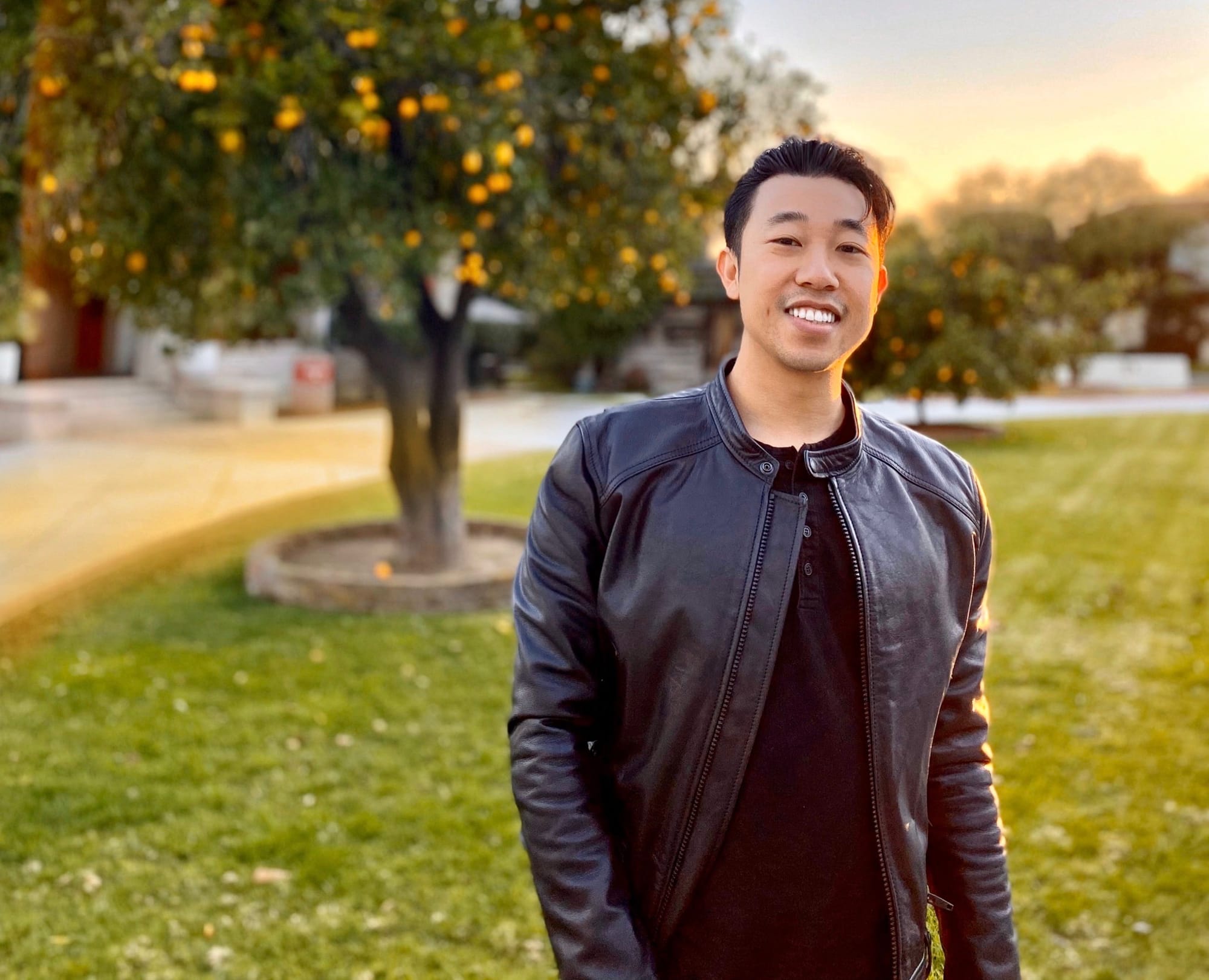
Substep 2A: Fill in the gaps in your MVP manually.
He moved the engineering team over to focus on building the community, and although a grand long-term vision was in his sights (like algorithmic recommendations, live events and social connectivity), Quan admits the first version of the product left a lot to be desired. “It was a really bad MVP. You didn’t even have the ability to communicate with other members. It was just a static, single-page of resources. I was personally curating the best resources about COVID that were helpful to CPOs and posting them on the forum page,” he says. “In the first few months, it was about creating a really valuable single-player experience. You could go into this ‘community’ and find the most timely pandemic-related resources compiled by me and other members. It had a few hundred articles, a dashboard tracking COVID cases, and all the legal guides we could find. It was very scrappy.”
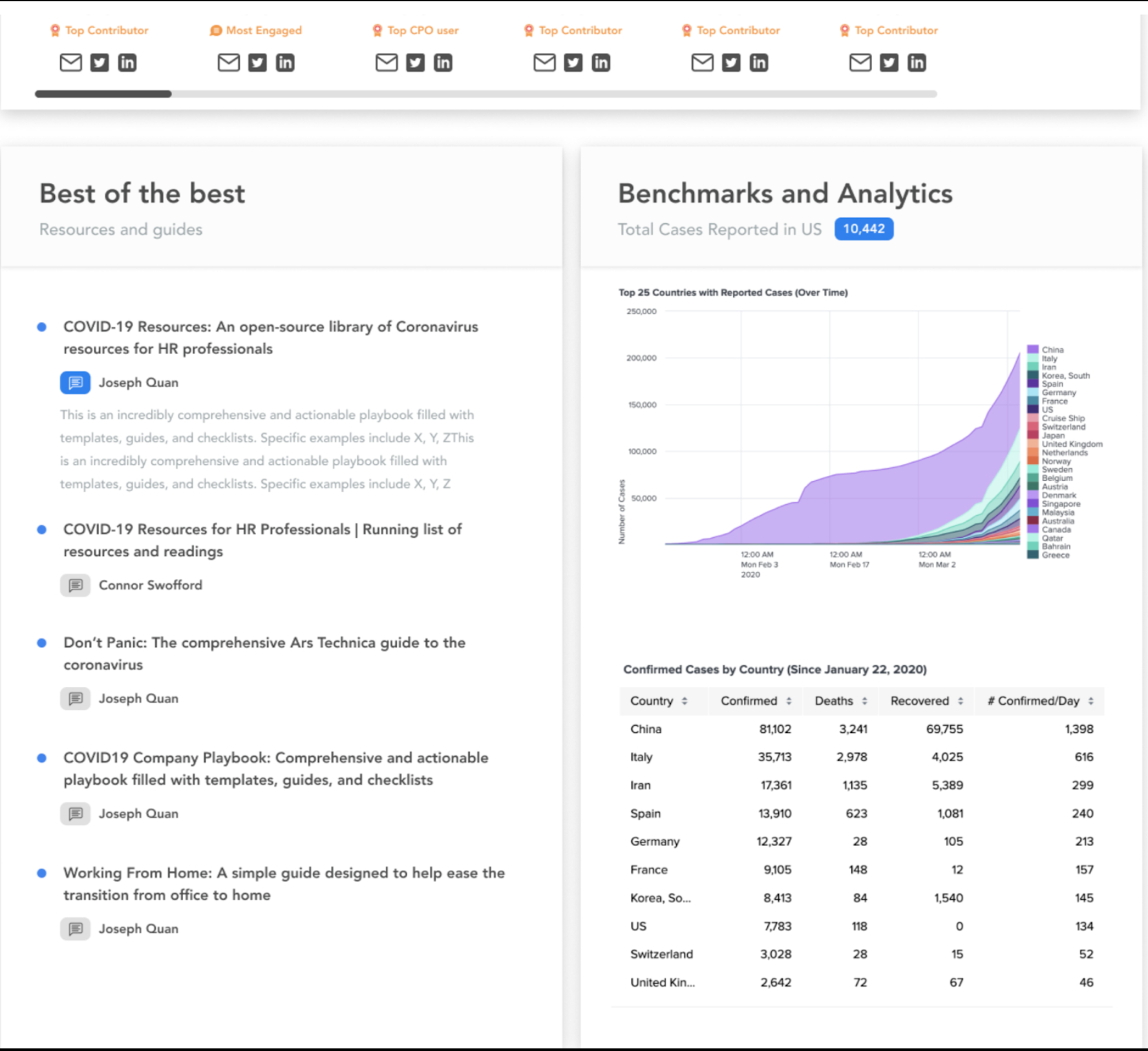
When you’re building a community from scratch, you don’t need all of the pieces at once. You just need to provide enough value to earn the right to get to the next step.
That single-player approach nabbed the first 50 or so weekly users, which was a combination of folks who signed on from the initial email campaign, and members that referred fellow CPOs. The Knoetic team deployed a few tactics to keep these early users engaged and logging into the community. “We manually updated content with fresh articles on a daily basis. We wanted this to be the hub where, instead of going to CNN or wherever you get your news, we create the habit of spending 5-10 minutes on our CPO community to get COVID news as it relates to the people leader’s job,” says Quan.
Substep 2B: Build a hype train.
He also nudged logins with regular email reminders. “We would send 2-3 emails a week alerting folks of new content updates or new members that were joining the community. We were constantly building momentum. We always wanted to prompt the reaction of, ‘Oh, wow another luminary CPO joined. They must see something in this community, otherwise the leader at Credit Karma wouldn’t be here.’ It helped build this continuing snowball of momentum, credibility, and desire,” says Quan.
- Mistake to avoid at this step: “Validate demand and build your MVP quickly, but know that building an enduring community takes time. Be patient. A community has the same cold start problem as a marketplace; our mental model is to treat our community like a marketplace of ideas, questions, and answers. Keep in mind that it will take over 3 months from that cold start to gain traction in a community. If you expect results overnight, you’ll give up far too easily. This must be a long term commitment,” he says.
STEP 3: NAIL YOUR ONBOARDING, IDENTIFY YOUR POWER USERS, AND SCALE UP.
Although the community itself was barebones, the onboarding experience was high-touch in the early days. “I personally onboarded the first 50 members. We would hop on a call for 30 minutes and I would walk them through every single feature in the community and how to use it,” he says.
Substep 3A: Build an engine for continuous learning.
Quan also used this opportunity to dive in deep with community members, with an eye towards later versions of the product. “I led with curiosity on each of my onboarding calls,” he says. “‘What’s your favorite feature, what would you cut out? How would you rate us today on a scale of 1-10? What would take us to a 10? What’s the one feature that would get you back in this community every single day? Let’s imagine in one year, this network ends up failing, why do you think it failed?’”
As an example, Quan heard again and again that community members wanted to be able to list their top priorities, so they could get reminders and personalized content recommendations based on those goals. That “Priorities” feature shot to the top of the Knoetic roadmap.
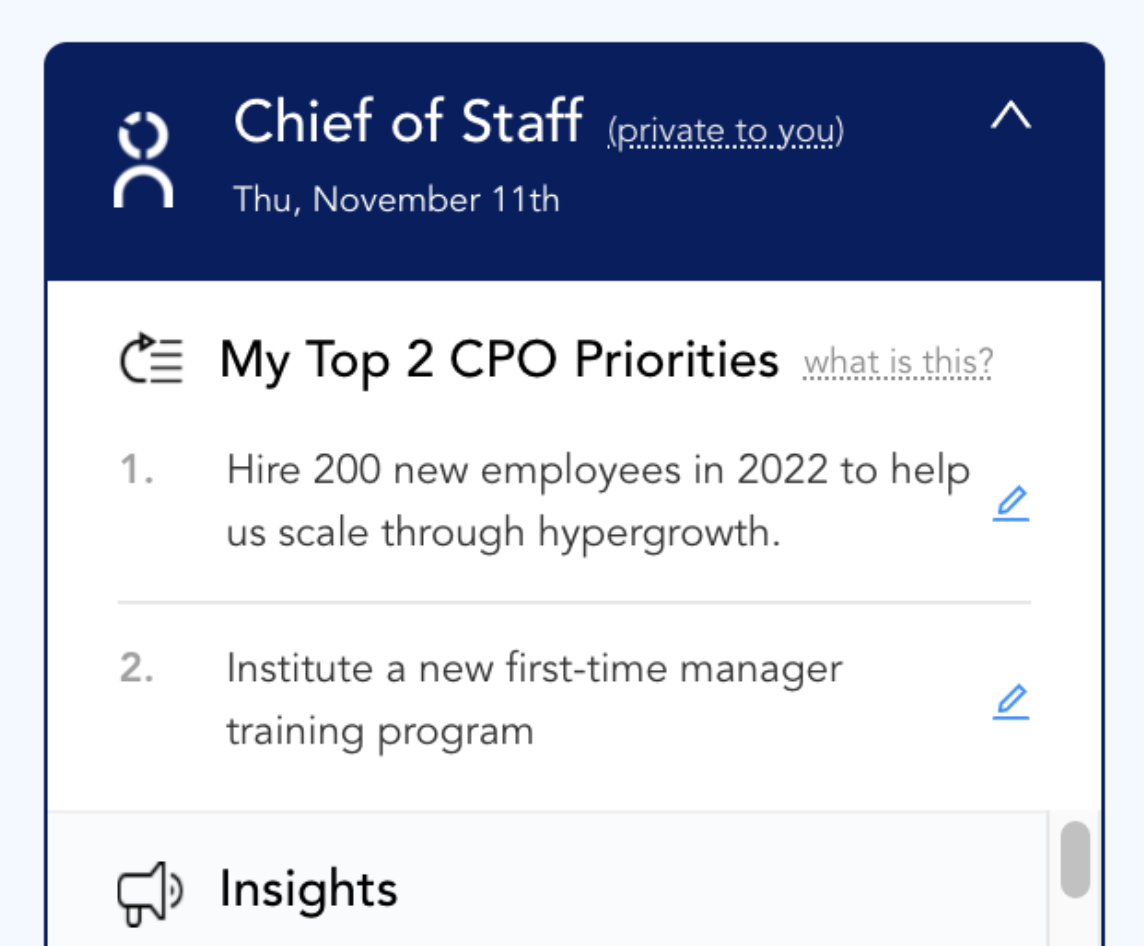
He also kept an eye out for members he felt were most likely to become power users. “It was about finding those 10 people who just believed in the vision. It’s the same at any startup — you’re trying to find those first 10 beta customers or design partners. Community is no different,” says Quan. “In our onboarding calls, I’d explain our vision to build the #1 CHRO/CPO network, develop the single largest compilation of playbooks in existence on how to run a strategic People/HR function, and so much more. That seemed far-fetched at the time when we only had a few dozen members. But I found the folks who really bought into this grander vision and wanted to be a part of it. Eventually, many of those community members even became investors in the company.”
Substep 3B: Seed the community with content and activate your power users.
And to give the community a jumpstart, he pulled out some proverbial jumper cables. “We had to fake it a bit until we made it. I would ping the CPOs we had identified as power users and ask them to post an article or a resource I had found — even going as far as to draft their posts for them to make their lives easier. When you finally get to a dozen engaged members who are posting over and over again, it actually ends up organically spurring that behavior from the rest of the community. Then you don’t have to prod people anymore — it just becomes an ingrained habit,” he says.
While today the community has grown beyond Quan’s capacity to onboard every single new member, CPOHQ still maintains a personal touch. “We’ve now built product-led onboarding, where you have a guided walkthrough and a checklist with the different actions we want you to complete in your first week — like asking your first question, responding to your first poll, or sharing your first playbook. On top of that, we still have someone on the community team onboard each person manually so we’re connecting with new members and providing that white-glove, concierge service from day one. It’s been instrumental to our success,” says Quan.
Substep 3C: Codify your founding principles — they become the DNA of the community.
Also part of the onboarding process from day one that’s stuck around? “Before we even built the community, I wrote down all of the principles that I envisioned we’d live out. Every single person who joins the community has to sign a letter committing to those principles — to maintain confidentiality, to be generous with your knowledge, and be a lifelong learner,” he says.
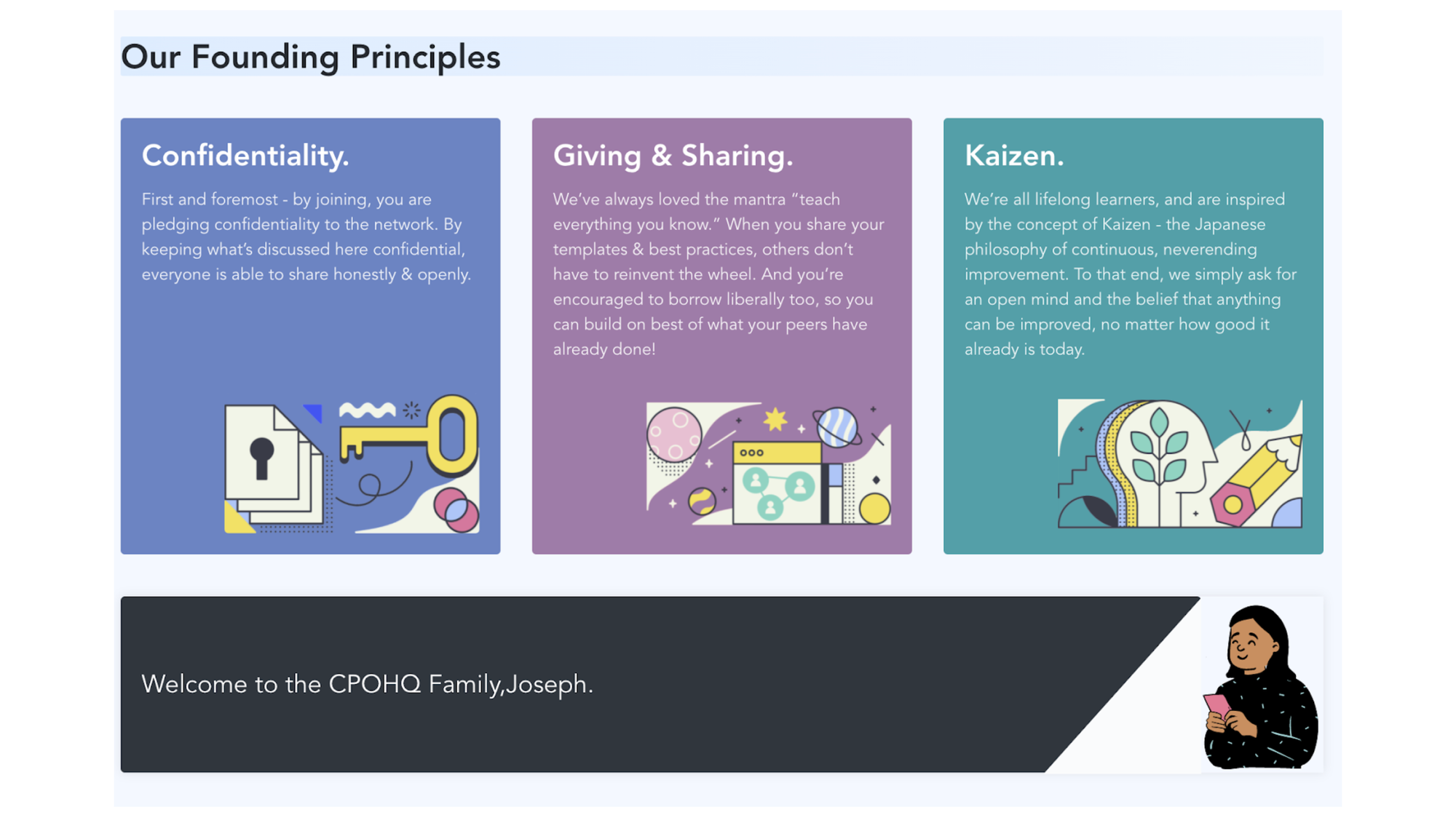
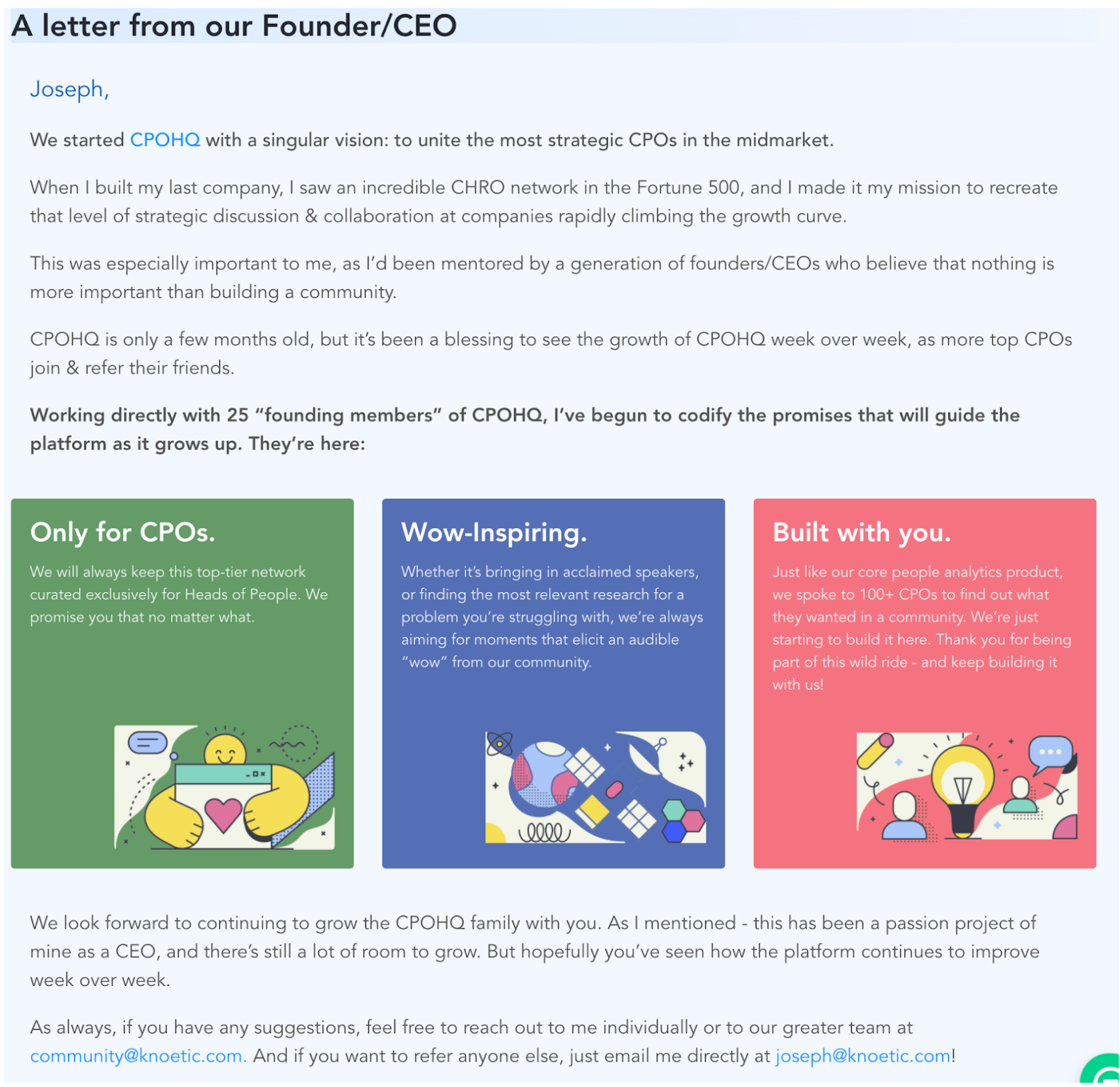
- Mistake to avoid at this step: “You can’t make a community for everyone, otherwise you end up making it for no one. We were very opinionated about having an incredibly high bar for who makes it into the community and who doesn’t, which was critical to our long-term success,” says Quan. “And to be clear, the playbook I’m sharing is for building exclusive communities of 1,000 to 10,000 of the world's top practitioners in a field. It's not for a platform that’s optimizing for breadth, like Reddit or Quora.”
STEP 4: EXPAND BEYOND YOUR MVP AND EXPERIMENT.
Substep 4A: Keep shipping!
Even with CPOHQ’s admittedly bare-bones single-player mode community, the team managed to build a user base of 40-50 CPOs logging in at least weekly. Months 3-9 on the community roadmap were dedicated to building out a plethora of social features — from a LinkedIn-like feed, to group polling, to a shared “library” where members could submit and share the best articles they found each month.
Once a community gets to a certain size, it’s common to expect new features to get traction organically. But building out the social features meant the team needed to pull a page from their earlier playbook to reinforce this new behavior. “It was an uphill battle,” Quan admits. “I needed to email all these CPOs and encourage them to ask a question in the community. Then, at a certain point, something clicked, and I no longer had to ask people to post questions — they’d just do it automatically.”
But then another problem popped up. “We had so many questions and no one was answering them. So then I had to manually prod users to answer their peers’ questions. It took months of grinding for question asking and answering behaviors to be engrained in the community. Now, it’s an organic flow of dozens of questions from Heads of People every single week, and even more answers flowing through the community,” says Quan. To ensure that ongoing engagement, his team deployed a mix of tools, including sending automated notifications, sharing curated digests of top content, and hiring a dedicated “community success manager.”
With each new action you add to your community, it will take tons of legwork, nudging and prompting to get your community members to follow suit.
Substep 4B: Co-create your roadmap with the community.
The CPOHQ team also tapped their community members to help crystallize the roadmap for what comes next. “For the entire first year of building the community, we had a weekly feedback session with our members. One of the pieces of feedback that came from those sessions was this idea of themed discussions. The opportunity to sit down in a smaller group for an hour with 10 or so other CPOs and bring, for example, your thorniest DEI challenges or your toughest compensation problems, and brainstorm solutions,” he says.
So the team started experimenting with small roundtables: “I would facilitate with a notetaker on the call, and we’d bring together top-notch CPOs or CHROs to brainstorm their return to office timelines, their compensation philosophy, their analytics strategy, or whatever else was top of mind. There’s a massive amount of intellectual capital created in these sessions. We’d condense the notes into a playbook that gets shared with each person in the community. That little nugget of an idea has become a massive value proposition for the CPOHQ community and has evolved to bigger events,” says Quan.
But just like any early product, that doesn’t mean every experiment at this stage will be a rousing success. “Members had been asking us for interest-based cohorts. So rather than this one macro feed with everyone sharing questions and resources, you’d have a themed section for diversity, COVID, B2B SaaS, hyper-growth, etc. That fell on its face because it cannibalized discussion from the main feed to these smaller groups. At the time, the community wasn’t big enough to sustain these smaller cohorts — I should have listened to my own intuition that we weren’t ready, rather than building it just because folks were asking for it,” says Quan.
But just because an experiment failed once, doesn’t mean it’s not worth revisiting further down the line. “MBA programs do this really well, where you have a class of 1,000 and then you’re split up into smaller cohorts. By doing so, you’re able to maintain and scale intimacy, while also growing the network. So our cohort experiment didn’t make sense at 200 members, but it’s something I’m interested in trying again now that we’ve crossed 1,000 members,” he says.
Substep 4C: Consider what would create a “seven-star” experience.
Quan also borrows a framework from Airbnb founder Brian Chesky. “In his interviews, Chesky often talks about the concept of the seven-star experience. Nowadays, five-star is just what’s baseline that your customers expect — it’s about finding those opportunities to propel the customer experience beyond those baseline expectations,” says Quan.
So what does that look like within the lens of community instead of a vacation rental? “We’re looking to create that personal, concierge experience from the moment you join the community. One of the things we do that I think is really special is we make sure every single question posed to the community is answered in at least 24 hours,” he says. Here’s why: “If you pose a question about a thorny problem to the community and you don’t get any response, that experience sticks with you — it’s embarrassing. So if none of our community members chime in, there’s a member of our team who will take an hour combing through the internet to compile a playbook with an answer for that member’s question. No matter what happens, we need everyone who joins to feel welcome.”
But a word of caution here — don’t look exclusively to the membership to tell you those opportunities to create a seven-star experience. “Quite often, community members just expect the minimum and are really bad at telling you what seven stars even looks like. This has to be founder or team-driven — you’re the ones that are thinking about community 24/7, consider the different levers you could pull to surprise and delight,” says Quan.
- Mistake to avoid at this step. “Testing is important, but given the effort required to ensure feature adoption, and the number of suggestions you'll be getting from your community members, you need to be thoughtful about how you execute. Develop a framework for prioritizing features and a process for testing, rather than trying to be everything for everybody. Also, a lot of our core bets on the community came from my own north star & vision for where we were going - not from a discovery call. It’s a fine balance, just like in product building.”
STEP 5: MEASURE WHAT MATTERS AND SHORE UP YOUR TEAM.
Just like any product you might create, it’s critical to keep a close eye on metrics — with the caveat that you’re tracking the right benchmarks at the right time. “There are a different set of metrics for every phase that you’re in — are you in the validation, growth or engagement phase?” says Quan. Here’s are some of the metrics he tracked for each phase of CPOHQ:
Substep 5A: Track the right metrics for the right moment of community-building.
Validation phase: “This is all about tracking if people are attracted to your idea. What are the email open rate and the email response rate? What is the application rate? And what is the activation rate — are people even logging in after they create an account?” The funnel metrics he tracked included:
- Email campaign open rate: Are folks opening the email advertising your community offering?
- Email campaign response/opt-in rate: How many are indicating some written interest in joining? Quan then sent those folks an application form.
- Community application rate: How many actually filled out the application?
- Community acceptance rate: “This is important when you’re building a more exclusive community, like we’re doing with CPOHQ. We’re tracking volume and quality of applications, as we want to make sure we’re being strategic about who will contribute to the dialogue of the community, rather than just blindly accepting anyone that requests to join,” says Quan.
- Activation rate/first-week logins: Once green-lit to join the community, how many folks are actually logging in for the very first time?
Growth phase: “The growth phase is, quite obviously, all about growth. All you're really looking at is are we tacking on another 50, 100, 200 members per month? Thus, the metrics we track are intentionally minimalist.” They boil down to just 2 KPIs:
- MoM growth: Quan set a goal for 10% monthly growth, but your own targets will depend on your community goals.
- WAU as a % of total users: “In addition to tracking monthly growth, we wanted to ensure that weekly active users weren't dramatically decreasing as we added new members. When you’re in a growth phase, you don’t want to worry too much if weekly active users drops by 5%. But if it starts dropping by 15% or more, you’ve got to start paying closer attention,” says Quan.
Engagement phase: “At the beginning of building this community we hypothesized that it would be at least a weekly active habit. If we succeed in our mission of building a community of knowledge and learning, then members should be engaging at least weekly. But we’ve recently begun to care more about daily active users, because we’ve earned the right to be entrenched in their daily workflow. How are you continuing to serve your most passionate members?”
- Weekly active users
- Daily active users
- DAU/WAU ratio
- Knowledge created: “We track the number of questions asked, questions answered, and a constellation of other in-app activities, and combine them into a single metric for all the knowledge being generated in the community,” says Quan.
Substep 5B: Build the team with care.
From a staffing perspective, with resources tight during the pivoting process, Quan served as de facto Head of Community for the first six months before passing along the lion’s share to his Chief of Staff. He didn’t make his first dedicated community hire until nearly a year into creating CPOHQ. “I would have made the community hire early instead of transitioning it to my Chief of Staff, but I just didn't have dollars, so that was more a function of necessity rather than structural need,” says Quan.
For other founders with a community that’s been quietly humming along, here’s his advice for shoring up your resources: “When you’re considering building out your community team, think about the jobs-to-be-done. For CPOHQ, the JTBD included content creation and curation, fostering social connectivity between members, and general community operations and analytics,” says Quan. “Take the time to outline your own community’s JTBD and how those align to the folks currently on the team, which will more clearly illuminate any gaps.”
- Mistake to avoid at this stage: “There are these famous benchmarks from tech companies that determine if a user will find value in the product. With Facebook, it was getting to your first 10 friends. With Twitter, it was following seven accounts. Just tracking the number of members in your community isn’t enough — you’ve got to find your own metric that is the best indicator of long-term retention, whether that’s downloading a resource or asking their first question, etc. First impressions are critical to the future of your community.”
STEP 6: REAP THE REWARDS AND LEVERAGE THE COMMUNITY TO SUPERCHARGE THE COMPANY.
After spending the last year and a half relentlessly building community, Quan is going back to his roots — building analytics software. “With the intensity of COVID settling down, it was clear that the CPOHQ community was still a critical part of our company offering, but it was becoming more self-sustaining,” he says.
Armed with insights from the community members providing a wellspring of ideas on what to build, he came to the realization that he wanted to build what he calls a “whole-brained product.” “In our product, the left hemisphere of the brain is the analytics engine. It’s what enables you to make dispassionate, data-driven decisions. It works by synthesizing millions of data points into metrics and insights for your team. But ultimately, the answers to these people issues can’t just be boiled down to a bunch of numbers on a page. Solving people problems takes emotional intelligence, visionary bets, and the wisdom of others. That’s where the right hemisphere of our product comes in," says Quan.
"The right brain is the community, CPOHQ. It’s discussion, it’s brainstorming, it’s idea sharing, it’s the coalescence of thousands of ideas from the world’s smartest Chief People Officers. We started thinking we’d build analytics and data tools, and now we’ve stumbled onto building a second brain for Chief People Officers instead. And that’s so much more valuable. Community has changed everything for us, as it’s woven itself into the DNA of the company and our product,” he says.
With that in mind, here’s how the CPOHQ community has supercharged Knoetic as a company.
Substep 6A: Start fundraising on the right footing.
“At the time we started looking to fundraise for Knoetic, we had hundreds of CPOs in our CPOHQ community. I can’t stress enough how critical this was for our fundraising efforts,” says Quan. “Our Series A lead investor came via a warm intro from one of our community members. There was incredible backchanneling in tandem done by dozens of community members that accelerated our raise.”
And once you’re in the room (or the Zoom) making your pitch, you’ve got a whole slew of data points to lean on. “Showing that 100s of people are joining a community that you’ve built from the ground up is a lot more compelling than someone armed with a few customer quotes and a hypothetical chart that’s up and to the right. You’ve suddenly created an army of positive references who are engaged in what you’re building, that investors can go talk to. It’s an incredible tool most founders don’t have in their arsenal,” says Quan.
If you choose the venture route later on, your proof points from the community will smooth your fundraising glide path.
Substep 6B: Craft the product with the continued guidance of your community.
Rather than building the analytics product in the basement, Quan and the Knoetic team had a direct line to what Chief People Officers care deeply about. “Customers and prospects aren’t always able to articulate what they want when they sit down with you. Or, as “The Mom Test” taught us, you’re often not asking the right questions,” says Quan. “But when you’re able to facilitate organic conversations amongst peers, you can spot patterns that keep coming up over and over again. In the CPOHQ community and at our live events, folks are diving deep into all sorts of topics that are mission-critical for their business, including compensation philosophies and return to work. Without the community, we wouldn’t have nearly the level of insights into what would-be analytics customers are looking for.”
The businesses that succeed have always been the ones that are closest to their customers. Being customer-obsessed means deeply understanding their problems — not just how they interact with your product. Those are critical insights a community delivers.
Substep 6C: Accelerate sales.
Acquiring customers is every startup founder’s relentless focus, especially in the earliest stages of building a product. But convincing prospects to swipe their card for a relatively unproven service is often an uphill battle. For Quan and the Knoetic team, the community was an invaluable proof point to lean on. “When we were launching Knoetic’s analytics product, we couldn’t advertise that we had 500 customers, but we could advertise that we had 500 leading CPOs in the community, which created a halo effect for the actual analytics product that we were selling, even though they were still quite distinct at the time. That created a lot of credibility,” says Quan. “On top of that, because so many Chief People Officers were using Knoetic’s community on a daily basis, they began to poke around our website and our app, leading them to organically discover the analytics offering. They’d reach out directly to us, asking how they could buy our SaaS product.”
Substep 6D: Connect your community members to create 10X value.
To close us out, Quan borrows from Adam Grant. “My personal philosophy as a founder is that the best way to build a lasting company is to create incredible value for everyone around you first. I don’t believe in transactional, tit-for-tat relationships. I believe you put a lot of goodwill and value out in the world for free, and it comes back to you in unpredictable, fortuitous ways. It’s something my former professor (and angel investor!) Adam Grant preaches. For me, community has been an easy way for me to generate a lot of value for others in a non-transactional way. I want every member to feel like they’re receiving an exclusive membership they’d pay $10,000 a year for - entirely for free,” he says.
“Through building the CPOHQ community, we’ve built incredible relationships with some of my favorite Chief People Officers in the world. But even more fulfilling has been seeing these folks build relationships with each other — from landing even bigger roles, to trading ideas on some of their thorniest challenges, to generously opening up their own playbooks for others to learn from. That’s what our community is all about,” says Quan.
